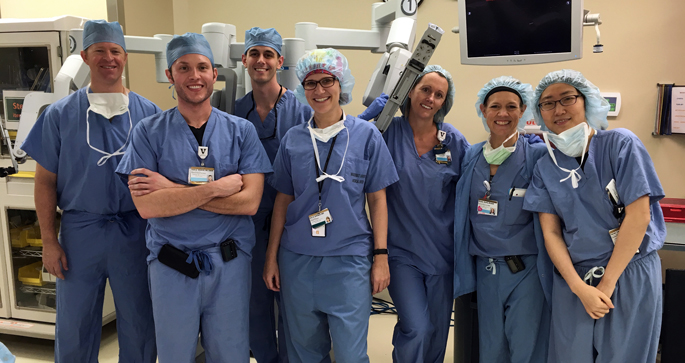
The thoracic surgery team at Vanderbilt University Medical Center recently added a new tool to its collection of minimally invasive techniques to provide patients the most advanced robotic-assisted surgical procedures.
“The new robot is an expansion of our minimally invasive surgery program,” said Erin Gillaspie, MD, assistant professor of Thoracic Surgery at Vanderbilt and director of the thoracic robotic program. “I am very excited about our team, the technology, the great patient outcomes and the bright future I am anticipating for this program.
“This newest technology has great benefits for both patients and surgeons.”
Gillaspie, who came to Vanderbilt in 2016, was eager to build the thoracic robotic surgery program upon her arrival. Introduced to the technology while a cardiothoracic surgery resident at Mayo Clinic in Rochester, Gillaspie won a robotics scholarship that allowed her additional, intensive training.
“I practiced and practiced and practiced some more,” laughed Gillaspie.
“I was absolutely amazed at the ease of performing surgery with the robot. This technology is outstanding for the type of surgeries we are doing. It is extraordinary how meticulously we can do these cases with the robot.”
Thoracic surgery is the latest specialty at the Medical Center to adopt the latest version of the robot — the daVinci Xi — which allows surgeons to perform delicate and complex procedures using a few small incisions.
Gillaspie sits at a console, a few feet away from the patient in the OR, to operate the arms of the robot while viewing her handiwork through a high-definition, 3-D screen that shows the inside of the patient’s body.
“The robot is replicating the movements of my hands,” said Gillaspie. “The robotic instruments we use have 7 degrees of freedom and 90 degrees of articulation, which is basically like having miniaturized hands inside the patient’s body. Every move I make is mirrored by the robot.
“My feet control the foot pedals that allow me to cauterize, switch between the different robotic arms and operate the camera,” she said.
“My fingers go into controllers which allows for precise, real-time movement of the instruments. And the view is unparalleled.”
Each instrument is designed for a specific task — clamping, cutting, dissecting and suturing.
Gillaspie said robotic-assisted operations have multiple advantages including reduction of post-operative pain and therefore decreased need for pain medication, shortened hospital stays, earlier patient mobility and faster recovery.
“While we had a very rich minimally invasive program before this robotic technology was introduced, this opens the doors to the types of procedures that we can do and the level of complexity that we can tackle,” she said.
Gillaspie said she and colleagues Eric Grogan, MD, and Jonathan Nesbitt, MD, are continuing to expand services to include esophageal and abdominal operations.












